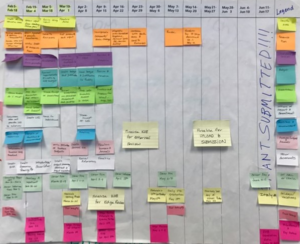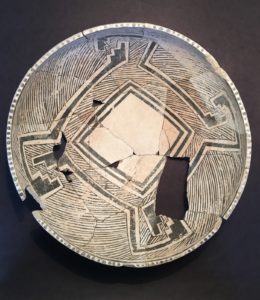What’s in Your Bucket(s)?
Once you’ve defined the buckets of work for your grant submission and placed them on your timeline, you are ready for the second step in the work breakdown process.
Recall that the purpose of work breakdown is to divide a large amount of work into manageable chunks. The first step was establishing buckets of work. The second step is defining tasks (activities) in each bucket. Tasks are specific actions you will take to complete each bucket of work. Tasks begin with a verb. Examples: conduct a comprehensive literature review, select your reference management software, track your list of references, schedule a consult with your statistician, determine whose biosketches you need.
Assignment:
- Select a single work bucket. Brainstorm all tasks you can think of that are associated with that particular piece of work. Write them down (paper, computer, tablet, or whatever works for you). Here is an example of suggested tasks related to Biosketches.
- Some people are fine with tasks that are fairly broadly stated. Others want them more granular. You determine the level of granularity in your task list. Review your list and combine tasks that logically seem to go together. Once your list is complete to your satisfaction, number the tasks in the order you plan to do them. Here is an example of the numbered Biosketch list.
-

Example of a completed timeline
Next, write each task on the same color of sticky note as the bucket. Each task gets a separate sticky note. I suggest arranging the sticky notes in reverse order to which you will do them Place them on your timeline in the appropriate column, starting from the submission date and working backward to the current date. Doing them in the reverse order helps you front-load tasks rather than push them to a time closer to the deadline. But do whatever works for you.
- Repeat until you have tasks assigned to all buckets of work and spread out on your timeline. Here is a list of suggested tasks for R buckets and K buckets for select elements in the checklist of NIH K components and R components. A completed timeline looks something like this or this.
- Once you have finished placing your tasks on the timeline, step back and look at it. Does the sequencing of tasks make sense? Can you do the amount of work you have planned in each of the given weeks? If you complete all tasks, will you be ready for your submission? Do you need to add more tasks? Make changes as you deem appropriate, but do not move milestones without a compelling reason to do so.
Congratulations! You now have a plan for completing a large amount of work over a reasonable period of time. To implement, look down the column for each week; those are the grant writing tasks you need to complete that week. As you finish a particular task, mark it off. If you are not able to complete all tasks in a given week, move unfinished tasks to another time. But beware of doing this! You can easily derail your plan by moving too many tasks to a future time.
I recommend saving your completed timeline, particularly for funding organizations to which you will apply multiple times (eg, NIH R proposals). The work breakdown will remain largely the same, so once you have a set of buckets and tasks that works for you, you can create a new timeline (or cut the dates off your original timeline and put in the new dates), change your milestones/important dates, make sure you are OK with the way tasks are allocated, and you are ready to go again.
This completes the series on grant pacing. If you have questions about this blog or any of the earlier ones in this series, contact Durango Kid by posting a comment. Comments will be forwarded to me and I will respond.
Previous Posts:
- #*@*! Plan Is Not a Four-Letter Word
- Planning to Plan: Gathering Materials
- Can You (Really) Do Your Proposed Study?
- Researchers–Start Your Timelines
- 500 Mile(stones)
- Buckets of Fun (Work?)






0 Comments